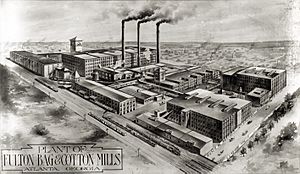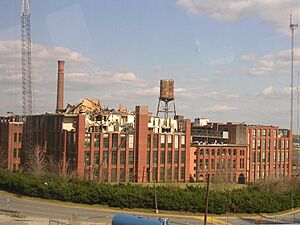Fulton Bag and Cotton Mills facts for kids
Quick facts for kids Fulton Bag and Cotton Mills |
|
 Plant of Fulton Bag and Cotton Mills, c. 1910–1930 |
|
| Location: | Cabbagetown, Atlanta, Georgia |
|---|---|
| Constructed: | 1881 |
The Fulton Bag and Cotton Mills was a big factory in the Cabbagetown area of Atlanta, Georgia. It started being built in 1881 near the Georgia Railroad tracks, where another factory used to be. Today, the old factory buildings have been turned into homes, like apartments called The Fulton Cotton Mill Lofts and condos called The Stacks.
Contents
How It All Started
The story of Fulton Bag and Cotton Mills began in Atlanta in 1868. A man named Jacob Elsas, who had recently moved from Germany, started a business selling rags, paper, and animal hides. He soon realized that other businesses, and even his own, needed bags and containers to hold their products.
Within a few years, Jacob Elsas changed his business to making cloth and paper bags. He teamed up with another German immigrant, Isaac May. In 1872, their new company was called Elsas, May and Company. Their first location was in an old market building in Atlanta. The company grew quickly during the 1870s. By the end of that time, they had a place to bleach cloth, a print shop, and a bag factory. They employed between 100 and 160 workers, including women and young people.
Building the Main Factory
With money help from a banker named Lewis Seasongood, the company started building a new, bigger factory. This new factory was located near the Georgia Railroad line, just east of downtown Atlanta. By 1881, the company was known as the Fulton Cotton Spinning Company. They added a bag factory to this new site in 1882.
By the late 1880s, Jacob Elsas and Isaac May went their separate ways. One part of the company became the Elsas, May Paper Company. The other part, led by Jacob Elsas, became the Fulton Bag and Cotton Mill Company in 1889.
The company grew so much that it needed even more space. A second mill was built in Atlanta in 1895. By 1907, a third mill was added. The company also built a village nearby with homes for its workers. Fulton Bag and Cotton Mills bought bag factories in New Orleans and St. Louis in the 1890s. They also opened new factories in New York and Dallas in the early 1900s. More factories were added in Minneapolis and Kansas City during and after World War I. A factory in Denver was added at the end of World War II in 1945. The Atlanta factory also kept growing, adding offices, storage buildings, and a clinic for workers and their families in the early 1940s.
Worker Strikes
Even though the company was doing well, there were times when workers were unhappy. In 1885, workers went on strike for two days because of a disagreement about their pay. Another short strike happened in 1897 when white workers protested because 25 Black women were hired. This strike ended after five days.
A longer strike began in 1914. This happened because the company didn't like that workers were trying to join a union called the United Textile Workers. Besides wanting to join a union, the workers also asked for more pay, a shorter work week (54 hours), and less use of child labor. This strike became famous across the country. The U.S. Commission on Industrial Relations even sent people to Atlanta in 1915 to hear what happened. However, the strike eventually failed in May 1915.
The Elsas Family's Role
Many members of Jacob Elsas's large family took on important jobs in the company, both in Atlanta and at other locations. When Jacob retired in 1914 at age 70, his son Oscar became the company president. His other sons, Victor, Louis, and David, worked in New Orleans, New York, and Dallas. Another son, Benjamin, took over as president after Oscar in 1924.
Later, Jacob's grandsons also led the company. Norman Elsas became president in 1942, followed by William Elsas in 1950. After William's sudden death, Clarence Elsas, another grandson, became president in 1951. Clarence Elsas was president until 1956, and again from 1960 to 1968.
Jacob Elsas also helped start the Georgia Institute of Technology, a famous university. He was one of their first customers and even sent his son Oscar there for two years. Other family members, like his grandson William, also went to Georgia Tech. Jacob Elsas also gave money to help others. He supported the Grand Opera House in Macon, a home for orphans, and Grady Hospital in Atlanta. Jacob Elsas passed away in 1931.
Changes After World War II
After World War II, how products were packaged started to change. This led to changes within the company. Fulton Bag and Cotton Mills began making new products like special paper bags, canvas items, and other materials to meet the needs of the new market.
In 1956, investors from the eastern and midwestern United States bought most of the company. The nine bag-making companies were sold off. In 1960, the main company became Fulton Industries Inc.. The Atlanta factory, still known as Fulton Cotton Mill, continued to operate with Elsas family members managing it until 1968. That year, Fulton Industries Inc. was sold to another company called Allied Products Corp. The last president of the Fulton Cotton Mill in Atlanta was Meno Schoenbach, who served from 1971 until 1978. That was the year the Atlanta factory finally closed its doors.
The Factory Today
In 1997, a company called Aderhold Properties started to fix up and change the old Fulton Cotton Mill buildings in Atlanta. They turned them into a community of 505 loft apartments, which they called "The Fulton Cotton Mill Lofts."
In 1999, while the buildings were being changed into apartments, a big fire broke out in one of them. The outside walls of the building survived, but everything inside had to be rebuilt. This fire, known as the "Cabbagetown loft fire," is still remembered because a crane operator was stuck at the top of a crane. He couldn't get down! People watched on live TV as an Atlanta Fire Department firefighter was lowered by a cable from a helicopter to rescue him.
In the early 2000s, many people in Atlanta wanted to buy condos. So, Aderhold Properties decided to turn three of the rental buildings into homes for sale. They called these condos "The Stacks." This name came from the old, tall smokestacks that still stand at the mill. It helped people tell the difference between the homes for sale and the apartments for rent.
On March 14, 2008, a strong tornado (an EF2 tornado) hit the area around 9:45 pm. Several buildings at the old mill were damaged. The roof was torn off one building, and the strong winds caused the top floor to collapse, making several floors below it fall like dominoes. This building had just started selling units, so only 15 homes had been sold, and luckily, only a few people were inside. Everyone escaped safely. Other buildings in the community were also damaged, and a decorative wall near the pool was destroyed.


